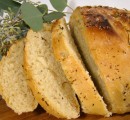The final recipe for the ancient holiday dinner menu is a dessert that stands the test of time. Presenting in a very lovely manner, the hazel-walnut honey custard is the perfect dessert that represents the ancient world and satisfies modern sensibilities. Nutty, sweetened with honey, visually pleasing and, of course, easy to prepare, make this dessert a part of whatever holiday menu you might choose. You’ll notice, of course, that this dessert is sweetened with honey. For the ancient Greeks honey was considered the food of the Gods. Praised by Homer in the Iliad and Odyssey and philosophical writings of Plato and Aristotle, honey found its way into many ancient texts, myths and legends. The Romans continued the practice of apiculture, using honey for both dietary and health requirements. According to The Philosopher’s Kitchen, where we found the recipe for this Hazel-Walnut Honey Custard walnuts were a child’s plaything. They... Read the Rest →
According to the cookbook The Philosopher’s Kitchen, the Etruscans, who settled the west coast of Italy in the 8th century BCE, made thick dough from ground grains that was baked under hot cooking ashes and then tipped with oils and herbs. The Romans called this bread panus focus. We know this bread as foccacia. It is one of the simplest breads to bake and its versatility has made it extremely popular in the past 10 years. Many regions of Italy have their own variety of flavorings that are add to their focaccia. Various versions of focaccia can also be found in other parts of the world. For example, in Burgundy, they call this bread foisse or fouaisse. In other areas of France it is known as fougasse. In Italy, for many centuries it has had an association with Christmas Eve and Epiphany. It is no wonder that this simple, versatile,... Read the Rest →
According to the cookbook The Philosopher’s Kitchen, the Etruscans, who settled the west coast of Italy in the 8th century BCE, made thick dough from ground grains that was baked under hot cooking ashes and then tipped with oils and herbs. The Romans called this bread panus focus. We know this bread as foccacia. It is one of the simplest breads to bake and its versatility has made it extremely popular in the past 10 years. Many regions of Italy have their own variety of flavorings that are add to their focaccia. Various versions of focaccia can also be found in other parts of the world. For example, in Burgundy, they call this bread foisse or fouaisse. In other areas of France it is known as fougasse. In Italy, for many centuries it has had an association with Christmas Eve and Epiphany. It is no wonder that this simple, versatile,... Read the Rest →



